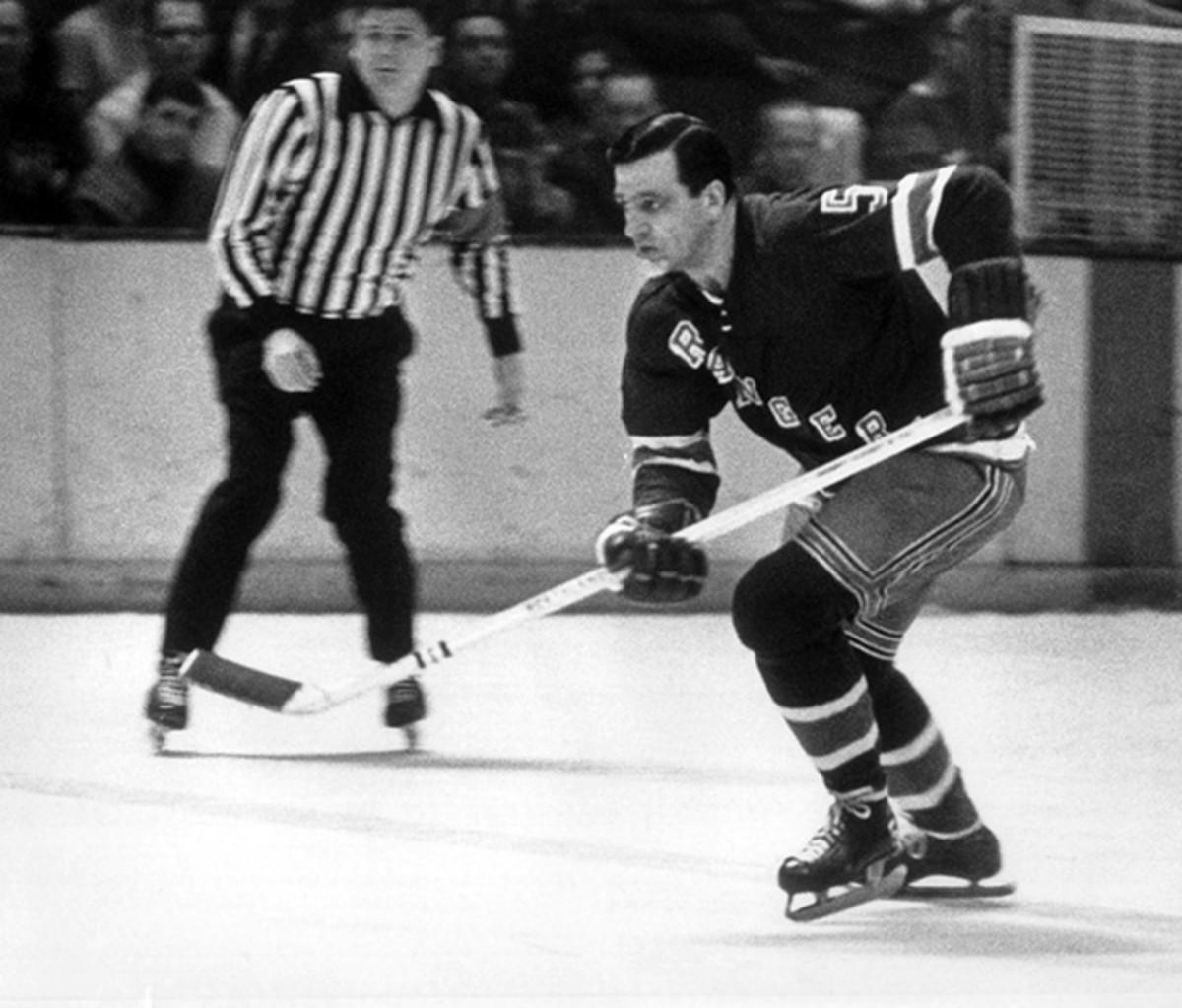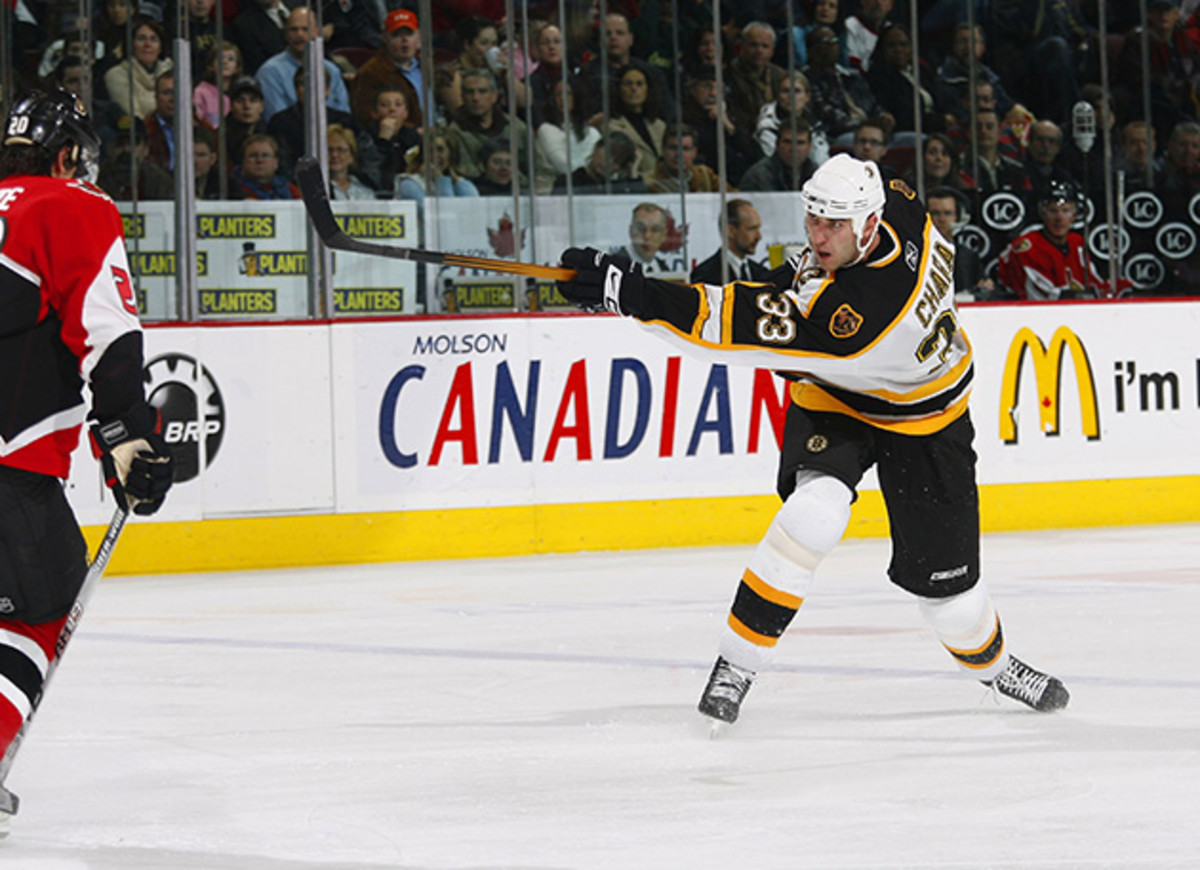The art of the slap shot: Chara shows there's more to it than Grip ’n’ Rip

Each sport has its own signature play or move that demonstrates pure power. A towering home run in baseball, an emphatic slam dunk in basketball, a knockout punch in boxing. In hockey, nothing says power better than a blistering slap shot. The slap shot has come a long way in the course of hockey history. What once was perceived simply as a shot that a player hits as hard as he can has become an art and a staple of the modern-day game.
Bernie (Boom Boom) Geoffrion, a player who started his NHL career with the Montreal Canadiens in 1950, claimed to have invented the slap shot. Back in the early ’50s the slap shot was not encouraged by coaches or even popular among players. It was said that the slap shot was risky and inefficient, that the shot took too long to execute, missed the net too often and gave the goaltender too much time to prepare.
While Geoffrion may or may not have invented the shot, Bobby Hull was the player who revolutionized the slap shot in the late ’50s and throughout the ’60s. Hull’s shot presented power and struck fear into opposing defenders and goalies. He showed that performing a slap shot was an art form that took precision, not merely blunt force.
Key elements of a typical slap shot allow it to be the hardest and most powerful shot on ice. It starts with the windup, pulling the stick back waist-high or higher before bringing it down to shoot the puck. It’s then important not to strike the puck directly, but to first hit the ice around six inches behind the puck. This causes the stick to bend while weight is shifted from the player's back leg to the front. The torque on the stick acts like a spring, supplying energy and power upon the follow through. The position of the player's feet in relation to the puck and the position of the hands on the stick also impact the quality of the slap shot.
Glen Tucker is a shooting expert who runs the Shoot to Score Shooting Academy. He has taught players of all ages and levels how to enhance all types of shots. Tucker refers to the process of a slap shot as a “nine-point comfort zone.” There are many relationships involved, such as puck-body and blade-ice. Each step in a fundamentally sound slap shot is important to a player’s individual technique.
How top NHL draft prospect Jack Eichel is building a pro-ready body
By the 1980s and ’90s, Al MacInnis and Brett Hull were two of the best-known slap shot threats in the game. Today, Boston Bruins captain ZedenoChara and Nashville Predators captain Shea Weber are known as the hardest shooters.
The basic process of taking a slap shot hasn’t changed much over the years, but it has become something that every single player uses, which was not always the case in the past. The different techniques have been broken down to a science so much that any player can develop a quality slap shot with practice. In the modern-day era the slap shot is used often as a one-time shot immediately off a pass, which gives the goalie less time to react. It’s used heavily on the power play and can be very effective when there is traffic in front of the net. A slap shot from long distance has a chance to find the net if a goalie is screened or if a player deflects the puck on its way towards the goal.
While the number of players with a slap shot in their arsenal has grown drastically, Chara stands out and has been firing booming shots for many years.
“It started at a very young age, pretty much when I was in my early teens,” says Chara. The Boston captain explains that to practice a quick motion growing up, he would swing the shaft of a stick that had no blade and was cemented into a pot. “It was so heavy that once I used a regular stick, it really felt like a feather.”
For his part, Tucker puts extra emphasis on having a quick stick when taking a slap shot. Still, he has been teaching players to better their shots for over 25 years and notes that while stick speed is key, every step of a slap shot must work together. Says Tucker: “The game is changing and that’s one of the biggest parts of my program, are we changing with it? It has become so fast.”

In addition to the speed of the game, another change that has affected the slap shot is new and improved stick technology. In 1995 the first composite sticks were introduced. Today, almost every player uses one-piece composite sticks, and it has made the average slap shot even faster. Also, every player can customize his sticks to his liking, whether it is the curve of the blade or the size of the length and width of the shaft for example. “Everything is so customized to perfection that all of those details are making players shoot harder and faster,” Chara says.
Every NHL player is capable of ripping a hard slap shot, but few bring the heat like Chara. One of the most popular events at each annual All-Star Skills Competition is the hardest-shot contest. The contestants get a skating start and slam the puck as hard as possible into the net. Chara set the NHL record in 2012 with a 108.8 mph blast, and that shot still reigns supreme today.
“It’s a little nerve-wracking, but I think it’s very exciting,” Chara says. “It is such a buildup before the competition and when it comes down to two guys in the finals going at it.” Chara compares the hardest-shot competition to a 100-meter sprint. Everyone knows it will last just a few seconds, but it's very entertaining and no one wants to miss it.
Preparing mind and body for the NHL with top draft prospect Noah Hanifin
Obviously, there’s a huge difference between shooting a slap shot in an All-Star competition and doing it in a game while defenders are closing in. Getting a quality slap shot off in a game today is usually more about quickness than power. Using a big windup before letting a slapper go isn’t as important as solid technique, and it also takes more time.
“Don’t ever sacrifice time for power,” says Tucker. He has helped polish the shots of some of the best players in the world, including Chara. “One thing I worked on with Zedeno [Chara] a lot is that you don’t have to load to the ceiling to have a great slap shot,” Tucker explains. It’s clear evidence of how far the shot itself has come and how much it has evolved. “Before it was just about grippin’ and rippin’, and that’s not something I teach," says Tucker. "There is an art to it.”
While guys like Chara obviously show how useful a quality slap shot can be, the company Sportvision is looking to take it a step further to show hockey fans in more detail. Sportvision has developed technologies that enhance the viewing experience of sports on television. They're responsible for such features as K-Zone in baseball and the unofficial yellow first-down line seen in college and NFL football broadcasts. The company has been in early stages of developing a tracking system for hockey that would change the way the average fan sees the game. With infrared tracking chips inside the puck, you would actually be able to see the trajectory and speed of a slap shot during a live broadcast.
What started as a shot known as risky and ineffective has become a dangerous weapon used by all hockey players. “It changed quite a bit: There were maybe a few guys in the early ’90’s that had a shot that you knew was an absolute bomb,” Chara says. “Now you’re seeing a lot of guys that have heavy shots and quick release shots.”

The slap shot has changed the way offenses operate strategically and the way teams play defense. When Chara is set up at the blue line in the offensive zone, defenses know that you can't give him the time and space or he'll tee one up. Defensemen literally risk their lives trying to block a shot like Chara’s, and opposing goalies dread having to face them.
Chara has great size and strength that few can match when it comes to blasting a shot, but the fact that so many players have an effective slap shot today shows the importance of improving technique. “His size and leverage and the velocity has a lot to do with the shot—but again, proper mechanics, “ Tucker notes, is the reason he's so good.
The slap shot will only continue to improve and evolve as the game does. Sportvision may change the way people see it in replays, but won’t be needed to prove that there’s a true art form to the slap shot that Tucker teaches almost everyday. Whether or not Sportvision technology is implemented into real games in the near future, the slap shot itself will be a staple in the game forever.
